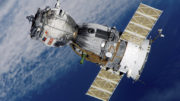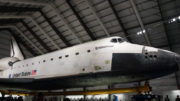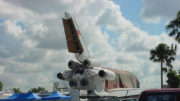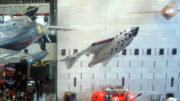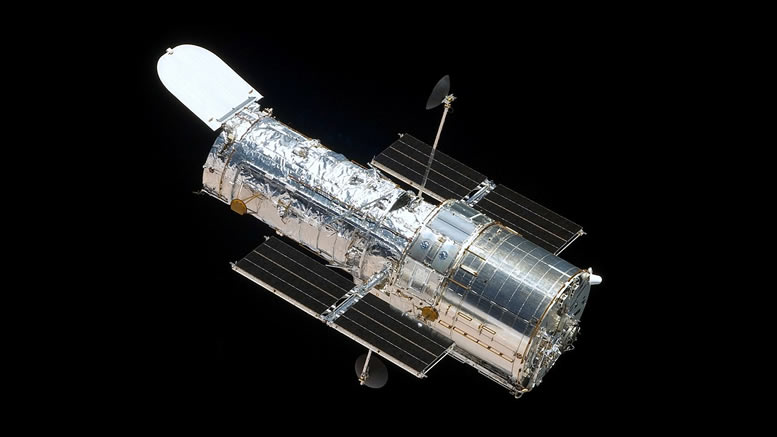 The Hubble Space Telescope or HST is a telescope located at the outer edges of Earth’s atmosphere, about 600 kilometres above the ground, orbiting the Earth every 100 minutes. It was placed into orbit, in April 1990, as a joint project of NASA and the ESA. It was Initially intended to be put into orbit in 1986 but Space Shuttle Challenger disaster of January 1986 cause major delays to all NASA missions. By placing a Telescope in space you don’t have to look through the Earths atmosphere which blocks out a board range of the Electromagnetic spectrum and blurs light, this lets astronomers see things in space you could never see from the ground.
The Hubble Space Telescope or HST is a telescope located at the outer edges of Earth’s atmosphere, about 600 kilometres above the ground, orbiting the Earth every 100 minutes. It was placed into orbit, in April 1990, as a joint project of NASA and the ESA. It was Initially intended to be put into orbit in 1986 but Space Shuttle Challenger disaster of January 1986 cause major delays to all NASA missions. By placing a Telescope in space you don’t have to look through the Earths atmosphere which blocks out a board range of the Electromagnetic spectrum and blurs light, this lets astronomers see things in space you could never see from the ground.
The telescope can achieve optical resolutions greater than 0.1 arc seconds. The HST is named after Edwin Hubble. Every day, the Hubble Space Telescope delivers between 10 and 15 gigabytes to astronomers. Working outside the atmosphere has advantages because the atmosphere obscures images and filters out electromagnetic radiation at certain wavelengths, mainly in the infrared.
Hubble weighs about 11,000 kilograms, is 13.2 meters long, has a maximum diameter of 4.2 meters and cost US$ 2 billion ($2,000,000,000). The telescope is a reflector with two mirrors; the main mirror has a diameter of about 2.4 meters.
The light collected and focused by the telescope ends up in one of several instruments. The instruments have been exchanged with different (and better) ones during the several maintenance missions.
Two solar panels provide electricity, which is mainly used to power the cameras and the four large flywheels used to orient and stabilize the telescope. The telescope’s infrared camera and multi object spectrometer also need to be cooled down to minus 180 degrees Celsius for operation.
The first images back from the telescope were generally regarded as a big disappointment for astronomers and all concerned in the project. They were blurred, and despite image processing could not match the predicted resolution. It was determined that the main mirror had been ground slightly too flat at the edges, a problem that could have been tested for on the ground if the funds had been available.
The telescope has been revisited several times by spacewalking astronauts in space shuttles in order to correct malfunctions, install new equipment, and boost Hubble back into a higher orbit as atmospheric drag causes Hubble to slowly fall out of orbit. the first mission was the mission to install the corrective lens to improve the focus of the images returned from Hubble. Later missions added new cameras and new instruments. other maintenance items on the list were replacement of solar arrays and a power supply unit that was never intended to be replaced in orbit. All these service missions have not only increased the life of the Hubble from an expected 15 years to 22 but have increase its usefulness by now being able to provide more information to scientists.
A 5th and final servicing mission was planned for February 2005 but now after the Space Shuttle Columbia disaster, all future shuttles must be inspected externally on orbit before re-entry, This means the shuttle must visit the international Space Station (ISS) on every visit to space. If the shuttle is damaged the crew can wait there for rescue by a Russian Soyuz spacecraft. This is why all future Hubble service missions have been cancelled as shuttle is incapable of reaching both HST and ISS during the same mission. There has been a huge outcry from astronomers regarding the decision to abandon Hubble so NASA is conducting a review to see if anything can be done to save the Hubble.
Hubble stays steady in space via the use of 6 gyroscopes, of which only 4 are working. It is possible for Hubble to operate on only 3 or maybe even 2 gyroscopes. it is also important to have as many working as possible to help Hubble stay in space. Atmospheric drag gradually lowers Hubble’s orbit as with one previous service mission it will need a boost to help it stay in orbit.
One problem with abandoning the Hubble is that not all of the telescope will burn up on re-entry. Parts of the main mirror and its support structure are expected to survive. NASA currently calculates a 1 in 700 chance of human fatality for a completely uncontrolled re-entry. NASA originally intended to attach a propulsion module to the satellite in a future mission, which would provide a controlled re-entry in 2010. At this time only Russia has the automatic docking capabilities to complete such a plan. Even this option is not simple, as Hubble has none of the active docking hardware required for the Russian automated docking systems to function. Hubble was designed to be able to be recaptured by the shuttle and returned to earth although cost has always been too expensive for this this option to ever be considered it is now impossible for the shuttle to visit any part of space not near the international space station.

